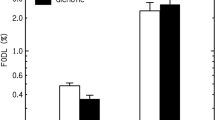Abstract
Discharges in cochlear nerve fibers evoked by low frequency phase-locked sinusoidal acoustic stimuli are synchronized to the stimulus waveform. Excitation and suppression regions of single units were explored using a stimulus composed of either a fixed intensity test tone at the characteristic frequency, a variable intensity interfering tone with a simple integer frequency relation to the characteristic frequency, or both. Compound period histograms were constructed from period histograms in response to normal and reversed polarity stimuli. Discharge patterns were characterized by Fourier components of the histogram envelopes. The two stimulus frequencies constituted the principal harmonics in the histogram envelopes and their combination accounted for observed rate changes. Suppression of the test tone harmonic as a function of interfering tone intensity was always seen; rate suppression was not. The harmonic was typically suppressed by 20–30 dB compared to the value for the test tone alone and often reached the 40–60 dB resolution limit of the experiment. Suppression plots were nearly linear on a power scale with an average slope of-0.8. The onset of suppression occurred for an interfering tone 9 dB greater on average than the test tone intensity. Information transfer through the peripheral system was described by the ratio of the principal harmonic amplitudes versus the ratio of the intensities of the two stimulus tones. These plots were nearly linear on a power scale with an average slope of 0.9. Neither the onset of suppression nor the slopes of the harmonic plots displayed strong dependence on characteristic frequency or interfering tone frequency. These features of harmonic behavior, however, are closely related to system nonlinearity. Comparison of measured harmonics to the predictions of two phenomenological models suggest the presence of complex nonlinear transformations in the peripheral auditory system.
Similar content being viewed by others
References
Anderson, D. J.: Quantitative model for the effects of stimulus frequency upon synchronization of auditory nerve discharges. J. acoust. Soc. Amer. 54, 361–364 (1973)
Arthur, R. M., Pfeiffer, R. R., Suga, N.: Properties of “two-tone inhibition” in primary auditory neurons. J. Physiol. (Lond.) 212, 593–609 (1971)
Blachman, N. M.: Band-pass nonlinearities. IEEE Trans. Inform. Theory. IT-10, 162–164 (1964)
Brugge, J. F., Anderson, D. J., Hind, J. E., Rose, J. E.: Time structure of discharges in single auditory nerve fibers of the squirrel monkey in response to complex periodic sounds. J. Neurophysiol. 32, 386–401 (1969)
Clark, W. A., Molnar, C. E.: A description of the LINC. In: Stacy, R. W., Waxman, B. D. (Eds.): Computers in biomedical research, Vol. II. New York: Academic Press 1965
Cooley, J. W., Tukey, J. W.: An algorithm for the machine calculation of complex Fourier series. Math. Comp. 19, 297–301 (1965)
Eldredge, D. H., Miller, J. D.: Physiology of hearing. Ann. Rev. Physiol. 33, 281–310 (1971)
Engebretson, A. M., Eldredge, D. H.: Model for the nonlinear characteristics of cochlear potentials. J. acoust. Soc. Amer. 44, 548–554 (1968)
Goblick, T. J., Jr., Pfeiffer, R. R.: Time domain measurements in cochlear nonlinearities using combination click stimuli. J. acoust. Soc. Amer. 46, 924–938 (1969)
Kim, D. O., Molnar, C. E., Pfeiffer, R. R.: A system of nonlinear differential equations modeling basilar-membrane motion. J. acoust. Soc. Amer. 54, 1517–1529 (1973)
Legouix, J. P., Remond, M. C., Greenbaum, H. B.: Interference and two-tone inhibition. J. acoust. Soc. Amer. 53, 409–419 (1973)
Molnar, C. E., Loeffel, R. G., Pfeiffer, R. R.: Distortion compensating condenser earphone driver for physiological studies. J. acoust. Soc. Amer. 43, 1177–1178 (1968)
Pfeiffer, R. R.: A model for two-tone inhibition of single cochlearnerve fibers. J. acoust. Soc. Amer. 48, 1373–1378 (1970)
Rhode, W. S.: Observations of the vibration of the basilar membrane in squirrel monkeys using the Mössbauer technique. J. acoust. Soc. Amer. 49, 1218–1231 (1971)
Rose, J. E., Kitzes, L. M., Gibson, M. M., Hind, J. E.: Observations on phase sensitive neurons of anteroventral cochlear nucleus of the cat: nonlinearity of cochlear output. J. Neurophysiol. 37, 218–253 (1974)
Sachs, M. B.: Stimulus-response relation for auditory-nerve fibers: two-tone stimuli. J. acoust. Soc. Amer. 45, 1025–1036 (1969)
Sachs, M. B., Kiang, N. Y. S.: Two-tone inhibition in auditory nerve fibers. J. acoust. Soc. Amer. 43, 1120–1128 (1968)
Author information
Authors and Affiliations
Rights and permissions
About this article
Cite this article
Arthur, R.M. Harmonic analysis of two-tone discharge patterns in cochlear nerve fibers. Biol. Cybernetics 22, 21–31 (1976). https://doi.org/10.1007/BF00340229
Received:
Issue Date:
DOI: https://doi.org/10.1007/BF00340229




